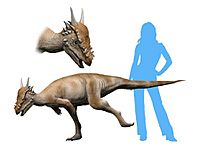Ferris Formation facts for kids
Quick facts for kids Ferris FormationStratigraphic range: Maastrichtian-Danian ~66–63Ma |
|
|---|---|
| Type | Geological formation |
| Underlies | Hanna Formation |
| Overlies | Medicine Bow Formation |
| Thickness | 600–2,000 m (2,000–6,600 ft) |
| Lithology | |
| Primary | Mudstone |
| Other | Sandstone |
| Location | |
| Coordinates | 41°48′N 106°36′W / 41.8°N 106.6°W |
| Approximate paleocoordinates | 48°48′N 82°12′W / 48.8°N 82.2°W |
| Region | |
| Country | |
| Extent | Hanna Basin |
The Ferris Formation is a special layer of rocks found in southern Wyoming, USA. It's a geological formation, which means it's a distinct rock unit that geologists study. These rocks formed a very long time ago, from the end of the Late Cretaceous period (about 66 million years ago) into the Paleocene period (from 66 to 63 million years ago).
During these ancient times, the area was a huge system of rivers and deltas. A delta is where a river spreads out and deposits sediment as it enters a larger body of water. Scientists have found many amazing fossils here. These include both body fossils (like bones and teeth) and trace fossils (like footprints or burrows).
Some of the most exciting finds are dinosaur remains, even if they are often broken pieces. Dinosaurs like Triceratops, Tyrannosaurus, Edmontosaurus, Ankylosaurus, and Pachycephalosaurus once roamed this land.
Interestingly, some of the ancient river channels in the Ferris Formation show signs of ocean water. This means that the western edge of the Western Interior Seaway (a huge ancient sea that once covered much of North America) was not too far away, even during the very end of the dinosaur age.
The Ferris Formation is also important because it contains the K-T boundary. This boundary marks the time when a major event happened on Earth, leading to the extinction of most dinosaurs. In this formation, scientists can see how life changed from the dinosaur-filled Cretaceous period to the mammal-dominated Paleocene period.
Contents
Ancient Animals of the Ferris Formation
Besides the many dinosaurs, scientists have found other ancient animals in the Ferris Formation. This collection of ancient animals is called the paleofauna.
Fish, Reptiles, and Mammals
Here are some of the other animals found in these rocks:
- Myledaphus (a type of ray)
- Lissodus (an ancient shark)
- Cretorectolobus (another ancient shark)
- Phylodus (a type of fish)
- Amia (a type of fish)
- Lepisosteus (a type of gar fish)
- Basilemys (an ancient turtle)
- Adocus (another ancient turtle)
- Leptochamops (a lizard-like reptile)
- Brachychampsa (an ancient alligator relative)
Scientists have also found many small ancient mammals, including multituberculates, marsupials, and placental mammals.
Ornithischian Dinosaurs
Ornithischians were a group of dinosaurs often called "bird-hipped" dinosaurs. They were mostly plant-eaters. Here are some found in the Ferris Formation:
| Ornithischians of the Ferris Formation | ||||||
|---|---|---|---|---|---|---|
| Genus | Species | Notes | Images | |||
| Ankylosaurus | Indeterminate | This armored dinosaur was like a living tank. | ||||
| Nodosauridae | Indeterminate | Another type of armored dinosaur, similar to Ankylosaurus. | ||||
| Stygimoloch | S. spinifer | A "dome-headed" dinosaur with spikes on its head. | ||||
| Thescelosaurus | Indeterminate | A small, agile plant-eating dinosaur. | ||||
| Triceratops | Indeterminate | This famous horned dinosaur's remains have been found here. | ||||
Saurischian Dinosaurs
Saurischians were another major group of dinosaurs, often called "lizard-hipped" dinosaurs. This group includes both giant long-necked plant-eaters and fierce meat-eaters. Here are some found in the Ferris Formation:
| Saurischians of the Ferris Formation | ||||||
|---|---|---|---|---|---|---|
| Genus | Species | Notes | Images | |||
| Ornithomimus | O. sp. | This dinosaur looked a bit like an ostrich and was likely a fast runner. | ||||
| Tyrannosaurus | T. rex | The mighty T. rex, one of the largest meat-eating dinosaurs, lived here. | ||||
Color key
|
Notes Uncertain or tentative taxa are in small text; |






